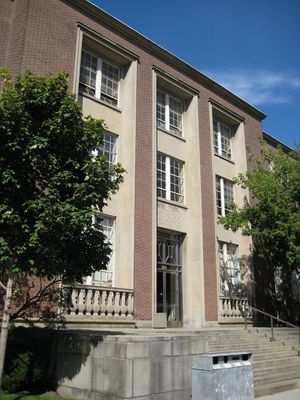Wallberg Building: Difference between revisions
Created page with "{{Infobox Building |name = Wallberg Memorial Building |image = Wallberg_Building.jpg |alt = Wallberg Memorial Building |caption = |year = 1949 |location = 184 College Street W..." |
added the "current" section |
||
| (4 intermediate revisions by 3 users not shown) | |||
| Line 14: | Line 14: | ||
|office5 = | |office5 = | ||
|office6 = }} | |office6 = }} | ||
The '''Wallberg Building''' (also the '''Wallberg Memorial Building'''), located on College Street West, is primarily used by the Department of Chemical Engineering, and includes most of the Chemical Engineering laboratories for undergraduates. The building was completed in 1949 and is named for Emil Andrew Wallberg, who had been president of Canada Wire and Cable and died in 1929. | The '''Wallberg Building''' (also the '''Wallberg Memorial Building'''), located on College Street West, is primarily used by the Department of Chemical Engineering and the Department of Materials Science and Engineering, and includes most of the Chemical Engineering laboratories for undergraduates. The building was completed in 1949 and is named for Emil Andrew Wallberg, who had been president of Canada Wire and Cable and died in 1929. | ||
==History== | ==History== | ||
The Wallberg Memorial Building was constructed and named as a result of a bequest by Ida Marie Wallberg in 1933, to commemorate her brother Emil Andrew Wallberg, former president of Canada Wire and Cable.<ref>L.W. Richards, ''University of Toronto: An Architectural Tour'', Princeton Architectural Press (New York: 2009).</ref> The start of construction was, however, delayed by World War Two and was not completed until 1949, during which period | The Wallberg Memorial Building was constructed and named as a result of a bequest by Ida Marie Wallberg in 1933, to commemorate her brother Emil Andrew Wallberg, former president of Canada Wire and Cable.<ref>L.W. Richards, ''University of Toronto: An Architectural Tour'', Princeton Architectural Press (New York: 2009).</ref> The start of construction was, however, delayed by World War Two and was not completed until 1949, during which period many engineering students were housed in [[Ajax Division]] due to the shortage of space and large influx of students. Wallberg was originally a one-story building with a basement floor. | ||
== Current == | |||
The Wallberg Memorial Building is home to the [[Materials Engineering|Materials Science and Engineering Department]] and the [[Chemical Engineering]] Department. The women's bathroom in the basement has seven sinks, three stalls, and an odd gap between the first stall and the wall. | |||
==References== | |||
<references/> | |||
[[Category:Buildings]] | |||
Latest revision as of 19:31, 8 August 2024
| Wallberg Memorial Building | |
|---|---|
 | |
| Location | 184 College Street West |
| Year Constructed | 1949 |
| Building Code | WB |
| Architects | Page & Steele Architects |
| Major Offices/Labs | |
| Department of Chemical Engineering | |
| Chemical Engineering Club | |
The Wallberg Building (also the Wallberg Memorial Building), located on College Street West, is primarily used by the Department of Chemical Engineering and the Department of Materials Science and Engineering, and includes most of the Chemical Engineering laboratories for undergraduates. The building was completed in 1949 and is named for Emil Andrew Wallberg, who had been president of Canada Wire and Cable and died in 1929.
History[edit | edit source]
The Wallberg Memorial Building was constructed and named as a result of a bequest by Ida Marie Wallberg in 1933, to commemorate her brother Emil Andrew Wallberg, former president of Canada Wire and Cable.[1] The start of construction was, however, delayed by World War Two and was not completed until 1949, during which period many engineering students were housed in Ajax Division due to the shortage of space and large influx of students. Wallberg was originally a one-story building with a basement floor.
Current[edit | edit source]
The Wallberg Memorial Building is home to the Materials Science and Engineering Department and the Chemical Engineering Department. The women's bathroom in the basement has seven sinks, three stalls, and an odd gap between the first stall and the wall.
References[edit | edit source]
- ↑ L.W. Richards, University of Toronto: An Architectural Tour, Princeton Architectural Press (New York: 2009).